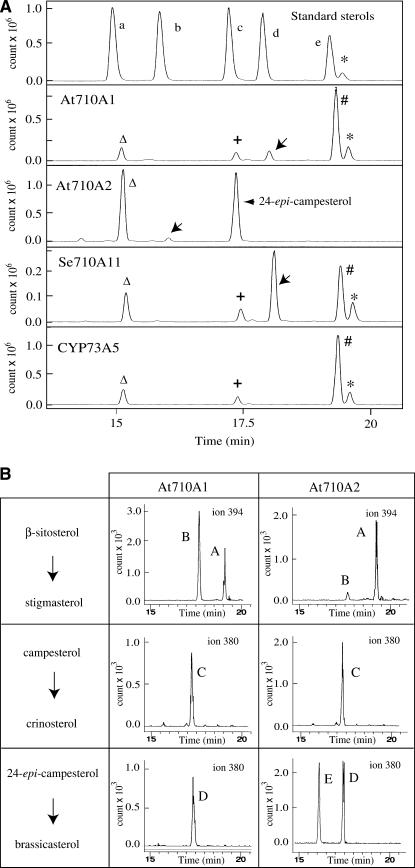Figure 4.
GC-MS Analysis of the Enzyme Reaction.
(A) Reaction products from the recombinant CYP710A assays were analyzed in GC-MS total ion chromatograms. The top panel represents the total ion chromatogram of standard sterols at specific retention times (RTs): a, cholesterol-trimethylsilyl (TMS) (RT = 15.5 min; mass-to-charge value [m/z] = 458); b, brassicasterol-TMS (RT = 16.4 min; m/z = 380); c, campesterol-TMS (RT = 17.4 min; m/z = 383); d, stigmasterol-TMS (RT = 18.5; m/z = 394); e, β-sitosterol (RT = 19.1; m/z = 396). The assays of the At 710A1 (with 10 pmoles of CYP710A1 P450/mL) and the 710A11 (with 20 pmoles of CYP710A11 P450/mL) proteins were done with β-sitosterol as the substrate (60-min reactions), and the At 710A2 assay (90-min reaction with 100 pmoles of CYP710A2 P450/mL) was performed using the synthesized 24-epi-campesterol (containing 30% campesterol as impurity) as the substrate (indicated by the arrowhead). The positions of the reaction products are indicated by the arrows. Sterol structures were identified by reference to relative RT and mass spectra. The pattern of fragment ions with m/z values of 484, 394, 255, and 129 were attributed to stigmasterol, and the fragment ions (m/z = 470, 380, 365, and 129) were used to identify brassicasterol/crinosterol. The 24-epimers were not separately analyzed under our experimental conditions. Campesterol and an unknown compound, both contaminants in β-sitosterol (substrate), are shown by a plus sign and an asterisk, respectively. Cholesterol (from the insect cell microsomes) and β-sitosterol (substrate) are indicated by open triangles (RT = 15.1 min) and pound signs, respectively. Recombinant CYP73A5 microsomes were used for the assay with β-sitosterol (bottom panel).
(B) GC-MS in SIM. A, β-sitosterol; B, stigmasterol; C, campesterol; D, 24-epi-campesterol (containing 30% campesterol as impurity); E, brassicasterol. The m/z value of 394 was used for SIM analysis of stigmasterol production, and m/z of 380 was used for the detection of brassicasterol/crinosterol.

